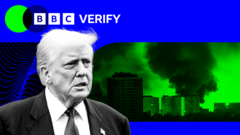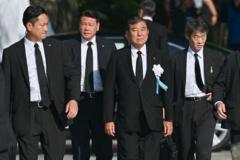Are Russian Attacks on Ukraine Doubling Despite Trump's Peace Efforts?

Understanding the Current Landscape of the Ukraine Conflict
The ongoing conflict between Russia and Ukraine has seen significant escalation in recent months, particularly since the return of Donald Trump to the presidency. An analysis reveals that the number of drones and missiles fired from Russia has more than doubled, coinciding with Trump's inauguration in January 2024. This surge in aerial attacks raises important questions about the dynamics of international relations and military strategy in the region.
In the lead-up to his presidency, Trump made bold claims about his ability to bring an end to the fighting in Ukraine, suggesting that a president respected by Russia could have averted the full-scale invasion. However, the reality of his administration's approach has led to criticism and accusations of favoring Russian interests over supporting Ukraine. This article delves into the complexities of the situation, examining the implications of Trump's policies, the increase in Russian attacks, and the impact on the Ukrainian population.
The Surge in Russian Military Activity
Data collected from the Ukrainian Air Force indicates that between January 20 and July 19, Russia launched a staggering 27,158 munitions at Ukraine, a stark contrast to the 11,614 attacks recorded during the last six months of Biden's administration. This increase in military aggression raises alarms about the potential for further escalation and the implications for civilian safety in Ukraine.
Contextualizing Military Strategy and Political Statements
In the initial weeks of Trump's administration, there were indications of a softer approach towards Russia, characterized by warm statements aimed at enticing President Vladimir Putin towards a ceasefire. However, the optimism was short-lived as attacks began to rise again, particularly after diplomatic talks in February failed to yield significant results. The pattern of escalating violence suggests a disconnect between political rhetoric and military action, leading to skepticism about the effectiveness of diplomatic efforts.
Trump's frustration with the increasing attacks has been vocal, yet it has not translated into a change in Moscow's aggressive strategy. This raises questions about the effectiveness of U.S. foreign policy and its impact on the conflict. As the number of attacks continues to grow, so does the urgency for a clear and consistent strategy from the U.S. government.
The Human Cost of War
The civilian population in Ukraine bears the brunt of the ongoing conflict, with daily life engulfed in uncertainty and fear. Reports from journalists and residents highlight the psychological toll of living under constant threat of aerial attacks. For many, the sound of explosions has become a grim part of their daily reality, leading to a pervasive sense of anxiety and despair.
Dasha Volk, a journalist living in Kyiv, expressed the emotional turmoil experienced by residents: "Every time you go to sleep, you don't know if you're going to wake up the next morning." This sentiment reflects the broader impact of the conflict on public morale and the challenges faced by individuals striving to maintain a sense of normalcy amid chaos.
International Responses and Military Support
The escalation of Russian attacks has reignited calls for increased military support for Ukraine. U.S. officials, including Senator Chris Coons, have emphasized the need for fresh supplies of advanced air defense systems, such as Patriot batteries, to counter the growing threat from Russian munitions. The complexity of military aid, however, is compounded by political considerations and the delicate balance of international relations.
Each Patriot battery comes at a significant cost, with estimates around $1 billion, and each missile priced at nearly $4 million. The financial implications of such support raise questions about the long-term sustainability of U.S. military assistance and the strategic calculations that underpin these decisions.
The Production Boom in Russia
Amidst the heightened aggression, Russian military production capabilities have surged, with reports indicating that Russia is now producing up to 85 ballistic missiles per month, a significant increase from previous figures. Additionally, the production of 'kamikaze' drones, such as the Geran-2, has reached alarming levels, with Russia reportedly manufacturing 170 drones daily. This rapid expansion of military capabilities poses a direct challenge to Ukraine's defensive efforts and raises concerns about the potential for prolonged conflict.
The establishment of a major manufacturing facility in Alabuga, touted as the largest combat drone production plant globally, underscores Russia's determination to bolster its military presence. As production facilities expand, the implications for regional security become increasingly pronounced, necessitating a robust response from Ukraine and its allies.
Future Implications for U.S. Foreign Policy
As the conflict continues to evolve, the role of U.S. foreign policy becomes ever more critical. The Biden administration's approach to military assistance has faced scrutiny, particularly in light of Trump's pauses in weapon supplies. Critics argue that these pauses may have emboldened Russia to escalate its attacks, highlighting the need for a more consistent and proactive strategy in supporting Ukraine.
Senator Coons has called for clarity from Washington, emphasizing that the U.S. must not convey a message of disengagement. The necessity for sustained military support and a clear stance against Russian aggression is paramount for achieving a resolution to the conflict. Additionally, the need for international collaboration and solidarity in addressing the crisis cannot be overstated.
Conclusion: A Path Forward
The dynamics of the Ukraine conflict are complex and multifaceted, influenced by political decisions, military strategies, and the lived experiences of civilians. As the situation unfolds, the imperative for a cohesive and strategic response from the U.S. and its allies remains vital in countering Russian aggression. The human cost of the conflict is profound, and the need for effective solutions to restore peace and security is urgent.
In the face of escalating violence, how can the international community effectively support Ukraine while navigating the complexities of diplomatic relations with Russia? The path forward requires a balanced approach that prioritizes security and humanitarian considerations, fostering hope for a more peaceful future.
FAQs
What has been the impact of Trump's return to office on the Ukraine conflict?
Since Trump's return to the presidency, there has been a notable increase in the number of drones and missiles fired from Russia towards Ukraine. This uptick in military activity has raised concerns about the effectiveness of U.S. foreign policy and its implications for the conflict.
How has the civilian population in Ukraine been affected by the ongoing conflict?
The civilian population in Ukraine faces daily threats from aerial attacks, leading to heightened anxiety and psychological stress. The uncertainty of living under constant threat has taken a toll on public morale and daily life.
What military support is being discussed for Ukraine?
There are ongoing discussions about increasing military support for Ukraine, including the potential deployment of advanced air defense systems like Patriot batteries. The cost and implications of such support are key considerations in these discussions.
As the world watches the situation unfold, the need for a cohesive and strategic response to the Ukraine conflict has never been more critical. What measures do you think should be taken to address the escalating violence? #UkraineConflict #MilitarySupport #InternationalRelations
Published: 2025-08-06 01:35:19 | Category: technology



